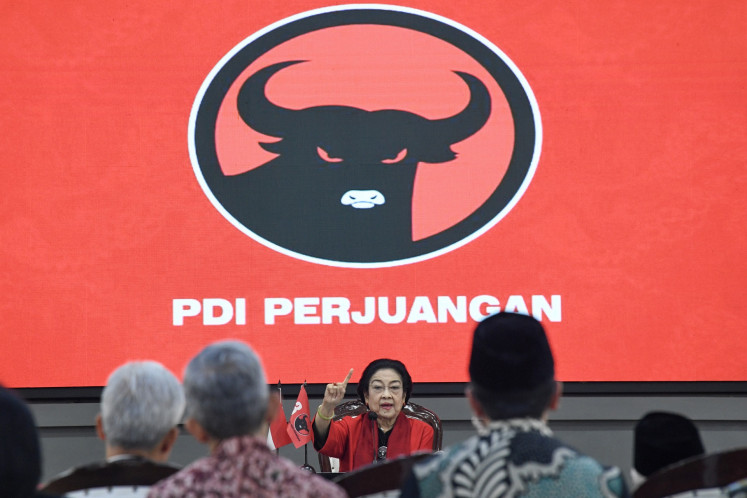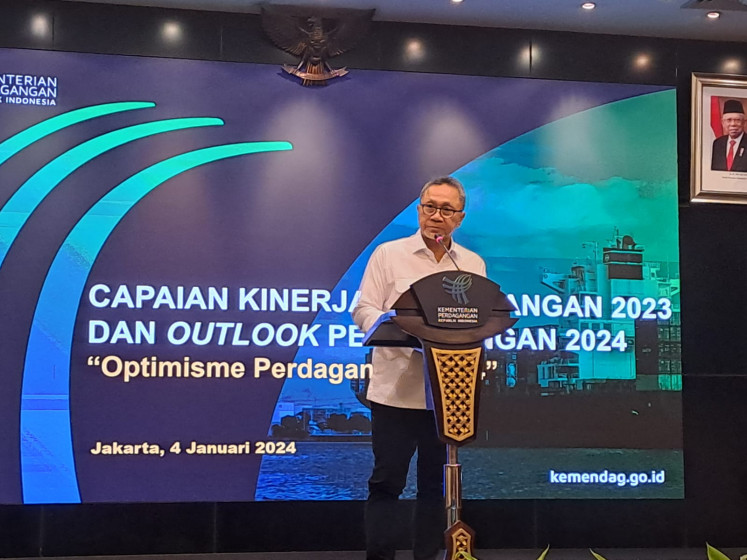Tapping coffee: potential on Merapi's slopes
Plenty to choose from: Various Indonesian coffee beans are seen stored in jars
Change Size

Plenty to choose from: Various Indonesian coffee beans are seen stored in jars.
The words 'Indonesian coffee' in the minds of most coffee aficionados would first bring up Gayo, Toraja or Papuan coffee, which have indeed come to prominence. However, Indonesia has more to offer to the world of coffee lovers.
Several coffee varieties with growing potential have emerged in various parts of Java, including one from the slopes of Mount Merapi, Yogyakarta.
'When I first surveyed the slopes of Mount Merapi, the land was still severely affected by the eruption of the volcano,' said food enthusiast Lisa Virgiano recently. At the time, the gastronomist observed the coffee potential on the mountain's slopes for the purpose of providing guidance for local coffee growers.
Sumijo, a coordinator of coffee farmers on the slopes of Mt. Merapi, said that after the land was damaged by hot volcanic ash, many farmers had changed jobs, becoming miners, motorcycle-taxi or truck drivers and tourist guides. Working on their own inherited land, they had earlier also been less inclined to develop their businesses and improve their crops.
Moreover, noted Sumijo, local farmers' coffee beans had also for a long time been purchased by middlemen based on pre-harvest deals at lower prices. Worse still, they hadn't yet developed the habit of drinking good quality coffee, consuming only what was left after being sold.
'They sold their best beans to middlemen and relished whatever was left, which they described as good enough to enjoy while chatting and smoking. How could they produce quality beans if they had never tasted good coffee,' he wondered.
Along with Sumijo, Lisa later gave guidance to motivate local coffee growers. Good quality beans can only be produced by monitoring plant conditions while in harvest season. Farmers were taught to measure the sugar contents of coffee beans at certain times to get the maximum level, which indicates the right time to harvest them.
The sugar content make the coffee taste fairly sweet, giving Merapi coffee its own characteristic flavor. According to Lisa, Merapi's Arabica and Robusta coffee varieties have the sweet taste of coconut sugar at the tongue tip, with the aroma of coconut and caramel as well. Merapi coffee beans are also medium sized and have a moderate level of acidity.

The characteristics of coffee in all regions varies, because of local soil properties and the other crops around the coffee plants. Such crops, as shown by Lisa, are needed to protect the plants from the heat of the sun and maintain the soil ecosystem.
The effort to promote good quality coffee beans then entered the next phase; properly marketing the products so that farmers' hard work would bear greater rewards. Lisa was searching for buyers to ensure the sales of farmers' coffee. The entire endeavor gradually came to life and strengthened the position of Merapi coffee and most importantly released farmers from the trap of middlemen.
'Consumer appreciation for coffee remains badly needed by Merapi coffee farmers,' indicated Lisa. This should be guaranteed by buyers' prices. It requires an alternative economic system to be applied to the sector of agriculture, instead of only relying on production quantity without putting regional quality and value adding to the fore.
Lisa can now feel relieved, as Merapi coffee has begun to be appreciated by coffee drinkers. Even more so, farmers are now capable of distinguishing between quality coffee and inferior coffee beans. 'They also keep the best beans for their own consumption so that they can enjoy the superior yields from their plantations,' she added.
Some coffee addicts assume that Arabica coffee is higher in quality than Robusta coffee. 'This is not entirely true,' said Lisa. Arabica is more expensive and more famous in the world coffee market because Brazil as the largest coffee producer in the globe produces Arabica.
As a result, coffee farmers in various countries are racing to grow Arabica in order to secure high prices. Actually, in some countries including Indonesia, there are other varieties like Liberica and Excelsa, whose quality is not inferior to Arabica with correct maintenance and processing.
Lisa pointed out the extra care demanded by the maintenance and planting of Arabica; among others, they must be grown at an altitude of 1,000 meters, a problem in Indonesia due to the inadequate infrastructure in mountainous areas. Arabica beans are smaller than Robusta, so that its percentage of red fruits with green beans is higher than Robusta, Liberica or Excelsa, meaning bigger production costs.
Lots of farmers are now growing Arabica coffee on their land as Robusta is seen as less attractive in price, although with proper processing Robusta can have specialty quality that sells for nearly as much as Arabica. This fact also threatens the diversity of coffee varieties in Indonesia and eventually the ecosystem of coffee and plantations as a whole.

Many varieties can be developed such as Liberica, capable of growing on lowlands and even peatlands, Excelsa, widely growing in people's plantations, and Maragogype, a genetic mutation from Arabica Typica. Each of them has its plus and minus points, but through creative processing the varieties can serve as food flavors, cosmetic materials and herbal drugs. Lisa has produced coffee vinegar for cooking from Excelsa by utilizing its strong acidity.
Creativity is the key to coffee development. Lisa has demonstrated that coffee beans less suitable for drinking can be processed into various other products, which will increase their value. In a culinary program she organized, Lisa offered fried rice and soup with coffee flavors. The seasoning taste can perfectly match the cooking as long as the characteristics of coffee beans used are identified.
As an effort to better promote and celebrate coffee as a beverage, the International Coffee Organization has decided to set Oct. 1, 2015, as the first International Coffee Day. Several countries have already set their own national coffee days. Indonesia, for example, set Aug. 17 as its national coffee day in 2006, in conjunction with its Independence Day.
' Photos by Juliana Harsanti









